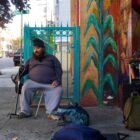Air quality took the spotlight during last week’s record-breaking heat wave when the thermometers maxed out at 106°F on Friday in San Francisco. The scorcher triggered a Spare the Air Day and overworked many an air conditioner, and air-pollution watchdogs were on hand to check out any dips in air quality caused by heat and smoke. Caught in the regulatory crosshairs was the soon-to-be-shuttered Russian Consulate in San Francisco. It got a visit from an air quality inspector all good and ready to check out reports of black smoke belching from the building’s chimney (ultimately, the Russians weren’t slapped with a ticket).
The air pollution problem, however, is a more permanent part of the environmental landscape in West Oakland, where emergency room visits for asthma top those in other parts of Oakland. Using a new measurement tool, a study has mapped pollution in West Oakland block by block, showing that pollutants can be six times more concentrated in one block as compared with those in the next. And San Francisco has a map of its pollution hot spots — the most besmirched being SoMa.
It appears that localized air pollution will continue to be an issue. California renewed its cap-and-trade program in July, which helps reduce greenhouse gases that contribute to global warming. However, that program has been faulted for its lack of successin preserving the air quality of communities — mostly low-income — near industrial polluters.
As for the drinking water supply in schools, it, too, could be more clean and pristine if it weren’t for annoyances like lead contamination. States acknowledge the risk but only six require testing for lead. California schools have access to free state-funded tests, but only 11 percent of K-through-12 schools have signed on.
But don’t assume that active steps are all that’s required to deal with pollution. There is the do-nothing approach, a.k.a. monitored natural attention, whereby environmental agencies can choose not to treat groundwater contamination at toxic cleanup sites and, instead, let it diminish over time, a technique that has been criticized for potentially harming drinking water supplies.
In the consumer sphere, there is no rest for the weary. It turns out that big impediments to the spread of cannabis in California aren’t the feds or pharmaceutical companies. Instead, the culprit is dirt in the form of mold, pesticides and toxic solvents. And if getting your nails done is your go-to form of relaxation, keep in mind that many nail workers are not only paid peanuts but are also exposed to a so-called toxic trio of chemicals: dibutyl phthalate, toluene and formaldehyde.
And then there are the natural toxins. Up and down the California coast, efforts are underway to save marine mammals from a deadly toxin, domoic acid, that causes potentially fatal domoic acid toxicosis.
It looks like the environment still needs a lot of help.
Keeping an Eye on the Right Wing
✤ If you are curious about who the conservative activists were who came to Berkeley to demonstrate last month, take a look at profiles a few of them in “Who Were the Trump Supporters Who Came to Berkeley on Aug. 27?” (Berkeleyside)
✤ And what if they hosted a right-wing rally and nobody came? Read all about it in “Amber Cummings Holds a Rally in Berkeley. This Time, No One Else Shows Up.” (Berkeleyside)









